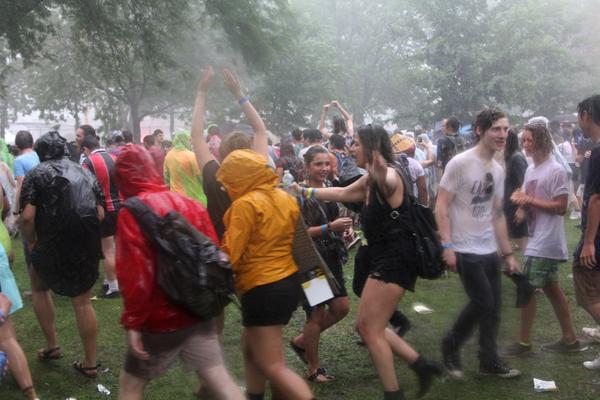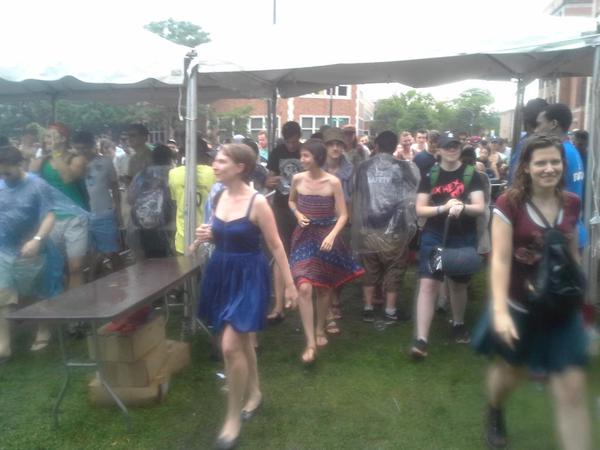Forget about Porta Potties and bad sound: Weather is the real problem
By Jim DeRogatis

Forget about Porta Potties and bad sound: Weather is the real problem
By Jim DeRogatis
In 2008, when the tornado sirens went off in Chicago on the Monday after Lollapalooza, I wondered what would have happened if that severe thunderstorm had hit a day or two earlier, when 100,000 people were getting high on groovy tunes and other pleasures in Grant Park.
As the pop music critic at The Chicago Sun-Times, I was frustrated at the time in my efforts to get an answer from the Police Department or the city’s Office of Emergency Management & Communications. Oh, there’s an evacuation plan for every major music festival, city officials assured me; they just couldn’t publicize it in advance “for security reasons.”
In 2012, city officials still wouldn’t answer the question when it was raised anew by Chicago Tribune investigative reporter Heather Gillers, who’d won nationwide acclaim for her coverage of the bad-weather stage collapse at the Indiana State Fair in 2011. Here’s the link to her piece, and here’s a link to the follow-up that I wrote at that time.
Ironically, not long after those pieces were published, we found out what the Lollapalooza evacuation plan was when violent weather descended on Lollapalooza 2012: Kick everybody out of the park and let them fend for themselves in a chaotic rush onto Michigan Avenue and Roosevelt Road.
The ensuing mess resulted in a fair amount of criticism, but city planners apparently haven’t come up with any better option in the years since. On Saturday, when severe weather blew over the Pitchfork Music Festival in Union Park, promoters cleared the site—kicking everybody out of the park and letting them fend for themselves in a chaotic rush onto Ashland Avenue and Lake Street.
Chicago Tribune freelancer Bob Gendron, covering the festival as rock critic Greg Kot’s wingman, gave us the breaking Tweets:
It seems clear #Pitchforkfest evacuating plan is same as Lolla a few years ago. In short: None.
— Bob Gendron (@BobGendron25) July 18, 2015People told to go to businesses on Ashland and Lake. Too bad they don’t exist. #Pitchforkfest
— Bob Gendron (@BobGendron25) July 18, 2015Watching people nearly get hit by cars fleeing the park in downpour not a pretty sight. This was very poorly handled. #Pitchforkfest
— Bob Gendron (@BobGendron25) July 18, 2015For his part, Kot followed up with a longer news story later in the weekend, noting that the crowd of 18,500 was rushed out of the park as the rain cut short a set by Ex Hex. The gates were opened again 70 minutes later, and Kot wrote that police reported no injuries. “We got lucky,” festival director Mike Reed told him. “It totally could have gone the other way.”
The troubling ramifications of that quote are that the city and concert promoters seem content to rely on luck as the best way to deal with massive crowds in weather emergencies—which, let’s face it, will inevitably happen again in Chicago in the summer.
It now seems obvious that there is no way to safely and quickly evacuate large crowds from city parks, which is why no one in the city has come up with a workable emergency plan. So what is the solution?
As I noted a few weeks ago when writing about Riot Fest being kicked out of Humboldt Park—the weather last year resulted in epic damage to that site, but didn’t cause an evacuation—it’s high time the mayor and City Council consider whether Chicago needs a permanent, safe, and secure festival site for all of these events to share, based on the model of the 75-acre Henry Maier Festival Park, home to Milwaukee Summerfest.
To be certain, money is tight in Chicago for civic improvements, and music festivals have to rank far down the list behind other priorities like the city schools and paying workers the pensions they’ve earned. But as I reported in that piece, Milwaukee’s festival site has been an economic boon to our sister city for decades. Amusement taxes on the big music festivals could fund the construction of such a site, without taxpayer money, and with the added bonus of people getting back their neighborhood parks during the summer months.
True, Summerfest had its own weather problems this year, and Milwaukee officials report that attendance was down: A mere 772,652 people attended this year’s event in late June and early July. But the jobs were as robust as ever, with 2,289 seasonal employees paid to work at the event.
A permanent festival site would still be subject to the weather, of course. But unlike the temporary facilities set up in the parks—and similar to permanent venues like Wrigley, Soldier Field, and Sox Park—bad weather planning would be part of the design, along with such niceties as permanent restroom, food, and drink facilities and better sound and sightline accommodations.
Now wouldn’t all of that beat another soggy mess in the mud?

Follow me on Twitter @JimDeRogatis, join me on Facebook, and podcast or stream Sound Opinions.
